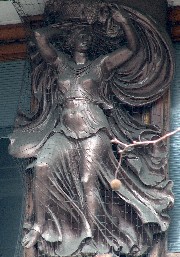 Bronze figure on the LSE.
Bronze figure on the LSE.
Aldwych is a semicircle of a street, beginning at Australia House on the Strand, and looping round to join the Strand again at almost opposite Somerset House. It is bisected by Kingsway, running north to Holborn Station.
We start at the eastern end, by Australia House (the sculpture on this building is pictured on this page, and the first thing we see on the right hand side is the London School of Economics building. Below the top of the portico, four bronze figures are on inner pillars, two female in flowing and clinging drapes owing something to the Greek naiads in the British Museum, and two knights with swords. All in the best taste. Left and right, minor entrances have two pairs of helmented cherubs, shields, and pots. Above centre behind the tree are two more feminine figures, with a child on the left hand side, and that on the right bearing a torch. Higher up, a bit small for the height above ground, a matched pair of reclining nudes. The bronze figures I am not sure of, but I would think that the stone figures, female and cherubic, are most certainly by the sculptor Albert Hodge.
Moving along, on the corner of Drury Lane is the Aldwych Theatre, by Phipps. High up on each of the Aldwych and Drury Lane frontages are triangular compositions of three sculpted figures, with musical and theatrical accoutrements. Much other decoration by way of garlands and wreaths in stone.
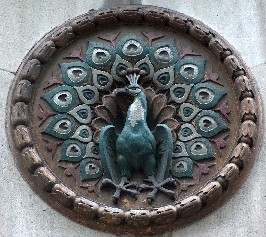
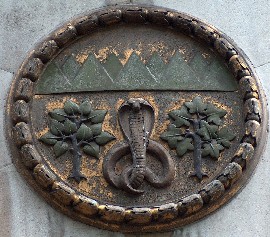 Motifs on on India House.
Motifs on on India House.
Directly opposite is India House, with little coloured roundels of animals and simple rather heraldic designs, including a peacock, elephant with howdah, camels and pyramids, St George in front of a castle and so forth (other sculpture of elephants can be seen on this page). The principal entrance has a pair of elephant based pillars, big cats on top, and elephants too form supporting brackets for the two main window pillars. But somehow all this looks rather lost on the vast bulk of this building.
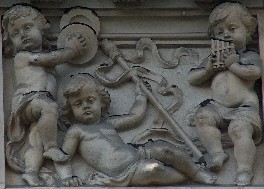 'Music', one of the panels on the Waldorf Hotel, by Emil Fuchs.
'Music', one of the panels on the Waldorf Hotel, by Emil Fuchs.
Opposite, next to Aldwych theatre is the big Waldorf Hotel (architect Marshall Mackenzie, 1906-8) – eight storeys high, very wide, and one of the great hotels of Edwardian times in London, in a sort of French style Classical idiom. Giant ionic pillars stretch over three floors, and about 15 square panels of cherubs or putti separated by small windows are above. Above this frieze are big pots on a balustrade, before the two attic levels are reached. The putti form clever, busy groups, engaged in sculpture, music, dance, architecture and so on (two more of the groups are shown on this page), but why oh why putti?. THe sculptor was Emil Fuchs, an Austrian, and there is some other work by him in England, including a very art nouveau angel in the Royal Mausoleum, Windsor. It is at least a rare treat to see work by an Austrian sculptor in London. The interior of the hotel, as it was when it was put up, is shown below.
Next along from the Waldorf is the Strand Theatre (now calling itself the Novello Theatre), similar to the Aldwych one and by the same architect, but with more by way of sculptural decoration on the upper floors. On each of the two frontages are 6 groups each of a girl and a cherub in alto relievo. The pediment above has a central lunette, flanked by figures of Comedy, Tragedy, and several cherubs holding garlands. Up at the top several fully articulated standing statues stand round the curved corner, consisting of girls representative of Poetry, again Tragedy and Comedy, and Music, all in soft stone and rather weathered.
 Part of the Frieze on the Strand Theatre.
Part of the Frieze on the Strand Theatre.
Back on the India House side, flanking it is a courtyard with a modern statue, and then number 326, Marconi House, the former Gaiety Restaurant, attached to the long-gone Gaiety Theatre, by Richard Norman Shaw. The building is at the time of writing being completely demolished, while retaining the important façade, currently unviewable. Important to us, because very high up it bears sculptural friezes by the elusive Hibbert Binney, a series of standing figures of Arts and Crafts girls. Bearing the motto ‘War to Uphold the Right to Peace’, War has sword and shield, the central figure (‘to uphold’) has a most symbolic pose and hairstyle and clothes with long sleeves – she is Justice with sword and scales. Peace has palm fronds, and nice plaited hair. Trumpetters, four on one side, three on the other, complete the series. And famous heroines, Olivia, Portia and Beatrice in a group, and a second group of Ophelia, Cleopatra and Juliet. Excellent stuff.
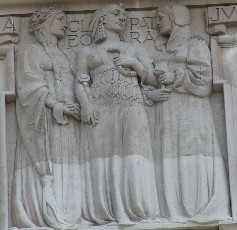 Cleopatra, by Hibbert Binney, in Aldwych.
Cleopatra, by Hibbert Binney, in Aldwych.
Thus ends the walk at the Strand, by Lancaster Place which goes alongside the Inland Revenue side of Somerset House, to the river and Embankment and Waterloo Bridge, or rightwards along the Strand to Charing Cross and Trafalgar Square, or left towards Fleet Street and thence to St Paul's.
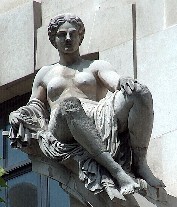 A reclining figure from the LSE, by Hodge.
A reclining figure from the LSE, by Hodge.
Walk along Kingsway // Walk along the Strand
At the East end of Aldwych - Gladstone Memorial // Australia House sculpture
Visits to this page from 23 Nov 2011: 9,043